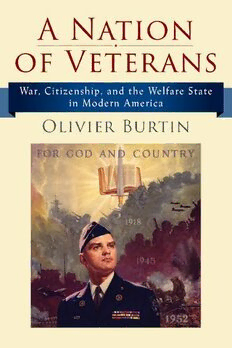
A Nation of Veterans: War, Citizenship, and the Welfare State in Modern America PDF
Preview A Nation of Veterans: War, Citizenship, and the Welfare State in Modern America
A Nation of Veterans A Nation of Veterans War, Citizenship, and the Welfare State in Modern America Olivier Burtin University of Pennsylvania Press Philadelphia Copyright © 2022 University of Pennsylvania Press All rights reserved. Except for brief quotations used for purposes of review or scholarly citation, none of this book may be reproduced in any form by any means without written permission from the publisher. Published by University of Pennsylvania Press Philadelphia, Pennsylvania 19104- 4112 www .upenn .edu /pennpress Printed in the United States of America on acid- free paper 10 9 8 7 6 5 4 3 2 1 Hardcover ISBN 9781512823141 Ebook ISBN 9781512823158 Library of Congress Cataloging- in- Publication Data Names: Burtin, Olivier, author. Title: A nation of veterans : war, citizenship, and the welfare state in modern America / Olivier Burtin. Description: Philadelphia : University of Pennsylvania Press, [2022] | Includes bibliographical references and index. Identifiers: LCCN 2022007571 | ISBN 9781512823141 (hardcover) Subjects: LCSH: Veterans—Government policy—United States—History—20th century. | Veterans—Services for—United States—History—20th century. | Veterans— Political activity—United States—History—20th century. | Welfare state—United States—History—20th century. | Public welfare—Political aspects—United States. | Veterans—United States—Societies, etc. | Veterans— Legal status, laws, etc.—United States. | United States—Social policy—History—20th century. Classification: LCC UB357 .B865 2022 | DDC 362.860973—dc23/eng/20220223 LC record available at https://lccn.loc.gov/2022007571 To my family and to the many friends made along the way Contents Introduction 1 PART I. ASCENT Chapter 1. Reform and Reaction: Veterans’ Politics in the Interwar Years 19 Chapter 2. Rebirth: The Veterans’ Movement in World War II 47 Chapter 3. Clash: Intergenerational Transition and the Postwar Housing Crisis 74 Chapter 4. Generations United: The Fight over the First Hoover Commission 100 PART II. ECLIPSE Chapter 5. A House Divided: Anticommunism and Its Discontents 129 Chapter 6. Consolidation and Backlash: The Korean War in the Shadow of World War II 157 Chapter 7. Generations Apart: The Problem of Economic Security for Aging Veterans 183 Epilogue. The Legacies of Martial Citizenship 209 viii Contents List of Abbreviations 219 Notes 221 Index 281 Acknowledgments 289 Introduction Military veterans were at the center of the U.S. welfare state in the mid- twentieth century. The annual cost of their benefits in the 1940s and 1950s represented an average of two-fi fths of all federal spending on social welfare, for a total of almost $100 billion over this entire period.1 Ranging from disability pensions to life insurance to civil service preference, the list of these programs was so extensive that beneficiaries needed self- help manuals to grasp their full scope.2 Taken as a whole, they formed what I call here the “veterans’ welfare state.” All these services were managed by a single mammoth agency, the Veterans Administration (VA), which was the predecessor of today’s Department of Veterans Affairs. It not only operated the largest hospital system in the nation but also employed more per- sonnel than any other federal entity save the military and the Post Office.3 VA staff served a clientele of over 20 million former service members in the postwar years, more than ever before in American history.4 Together with their relatives, veterans represented an estimated 40 percent of the U.S. population during this period, leading some commentators to argue that the country was fast turning into “a nation of veterans.”5 The substantial size of their benefits led the magazine Fortune to note in 1952 that the U.S. “welfare state” was really “a veterans’ state.”6 Other observers concurred, calling veterans “our biggest privileged class.”7 This last comment was meant to be provocative, but it was an understate- ment. There is indeed evidence to suggest that the benefits available to American veterans in the mid- twentieth century were more generous than those accessible not only to other categories of the U.S. population but also to their counterparts overseas. In a report to Congress in 1945, financier and statesman Bernard Baruch found that “in the main the provisions enacted . . . for American veterans are more liberal than comparable programs” in other industrialized countries such as Australia, Canada, Britain, New Zealand, and the Union of South Africa.8 Canadian expert and government official Robert England agreed, noting a few years later that while his country practiced a similar “segregation of the veteran [from the civilian] in all welfare and rehabilitation programmes,” the United
